What Does Butterfly Pea Tea Taste Like?
Butterfly pea tea, derived from the petals of the Clitoria ternatea plant, offers a unique sensory experience. When steeped, these deep blue petals impart a vibrant hue to the water, creating an alluring visual appeal.
Taste Profile:
The flavor of butterfly pea tea is often described as earthy and woody, with a slight floral undertone. It is mild and subtly aromatic, not overpowering, which makes it suitable for blending with other flavors such as lemon or honey.
Preparation Methods:
Bestsellers
- Hot Infusion: Steep in boiling water for 5 to 10 minutes.
- Cold Brew: Soak overnight in cold water for a refreshing twist.
Color-Changing Property:
One fascinating characteristic is its natural pH sensitivity. Adding lemon juice or other acidic components alters the tea’s color from blue to purple, adding a visual aspect to your tea-drinking experience.
Caffeine Content:
It’s naturally caffeine-free, making it an ideal beverage for any time of day or night.
Potential Benefits:
- Rich in antioxidants
- May enhance mood and cognitive function
Flavor Enhancements:
For added taste, infusing the tea with:
- Citrus
- Lemongrass
- Mint
- Ginger
Versatility:
You can enjoy butterfly pea tea both hot and cold, or even use it as a base for cocktails and culinary creations. Its mild taste and stunning color make it a popular choice for adding a touch of elegance to dining events and social gatherings.
Taste Profile
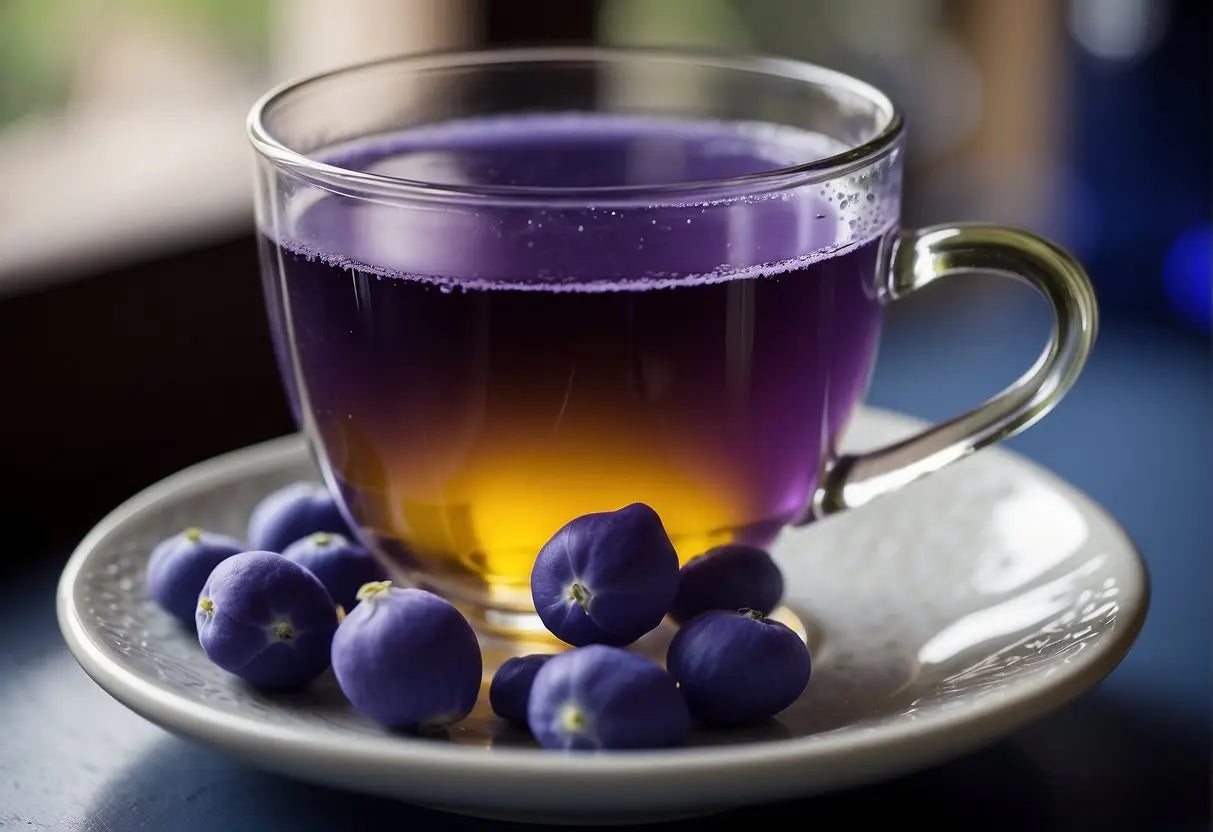
Butterfly pea tea offers a unique sensory experience defined by its distinct flavor notes and balance of sweetness and acidity.
Flavor Notes
When you sip butterfly pea tea, you'll notice a subtle earthiness reminiscent of the taste of unsweetened green tea. Grassy undertones and a hint of floral essence characterize its flavor profile. Unlike teas that have a bold or overpowering taste, the flavor of butterfly pea tea is notably mild and smooth, offering a calming drinking experience.
Sweetness and Acidity
The natural sweetness you taste in butterfly pea tea is gentle and never overpowering. You won't find the sugary profile like that of fruit teas, but rather a soft, mellow sweetness. Acidity is almost absent in this tea, distinguishing it from more astringent teas. In terms of pH level, it’s quite neutral, contributing to its easy-to-drink quality.
Culinary Uses

Butterfly pea tea is a versatile ingredient in your culinary arsenal. Its unique color-changing properties make it a popular choice for innovative drinks and a natural dye in various dishes.
- Beverages: You can infuse butterfly pea tea into cocktails or mocktails to impress guests with color-changing effects. Adding citrus or acidic components turns the blue hue to purple.
- Rice Dishes: For a vibrant touch, soak rice in butterfly pea tea before cooking to impart a stunning blue color.
- Desserts: Use the tea to color cakes, puddings, or dough for a natural food dye. It offers a mild flavor, ensuring it doesn't overpower your dessert's taste profile.
Pairing: Butterfly pea tea has a subtle earthy taste, which pairs well with:
Lao Ban Zhang
- Lemon and honey in drinks
- Coconut milk in Southeast Asian cuisines
- Light spices such as cinnamon or cardamom in sweet dishes
Pro Tip: Steep the tea in hot water to extract maximum color, then let it cool if you're using it in cold dishes or drinks. Remember, the flower's blue pigment is sensitive to pH levels, which you can use to your advantage for playful culinary presentations.
Brewing Techniques

The right brewing technique can significantly affect the flavor and color of your butterfly pea tea. Understanding how brew time and water temperature influence your tea will help you achieve the desired taste.
Effect of Brew Time
- Shorter Brew Time (1-3 minutes): Yields a lighter, more delicate floral flavor.
- Longer Brew Time (5-10 minutes): Results in a deeper, more pronounced earthy taste.
Infusing the butterfly pea flowers for varying durations changes the intensity of the tea's flavor. A shorter infusion time typically produces a milder tea, whereas a longer period allows for a full extraction of flavors, resulting in a stronger taste.
Impact of Water Temperature
- Colder Water: Subtle and refreshing with a mild taste.
- Hot Water (around 208°F/98°C): Enhances the tea's natural flavors, bringing out a more vivid taste.
Using hot water is crucial for a proper infusion of butterfly pea tea. However, the temperature shouldn't exceed the recommended range, as overly hot water can lead to a bitter taste.
| Water Temperature | Taste Profile |
|---|---|
| Cold brew | Delicate & subtle |
| Warm (160°F/71°C) | Soothing & mild |
| Hot (208°F/98°C) | Bold & full-flavored |
Hotter water encourages a faster release of the tea's blue pigments and flavors, creating a vibrant blue hue and a more robust taste profile.
Comparisons with Other Teas
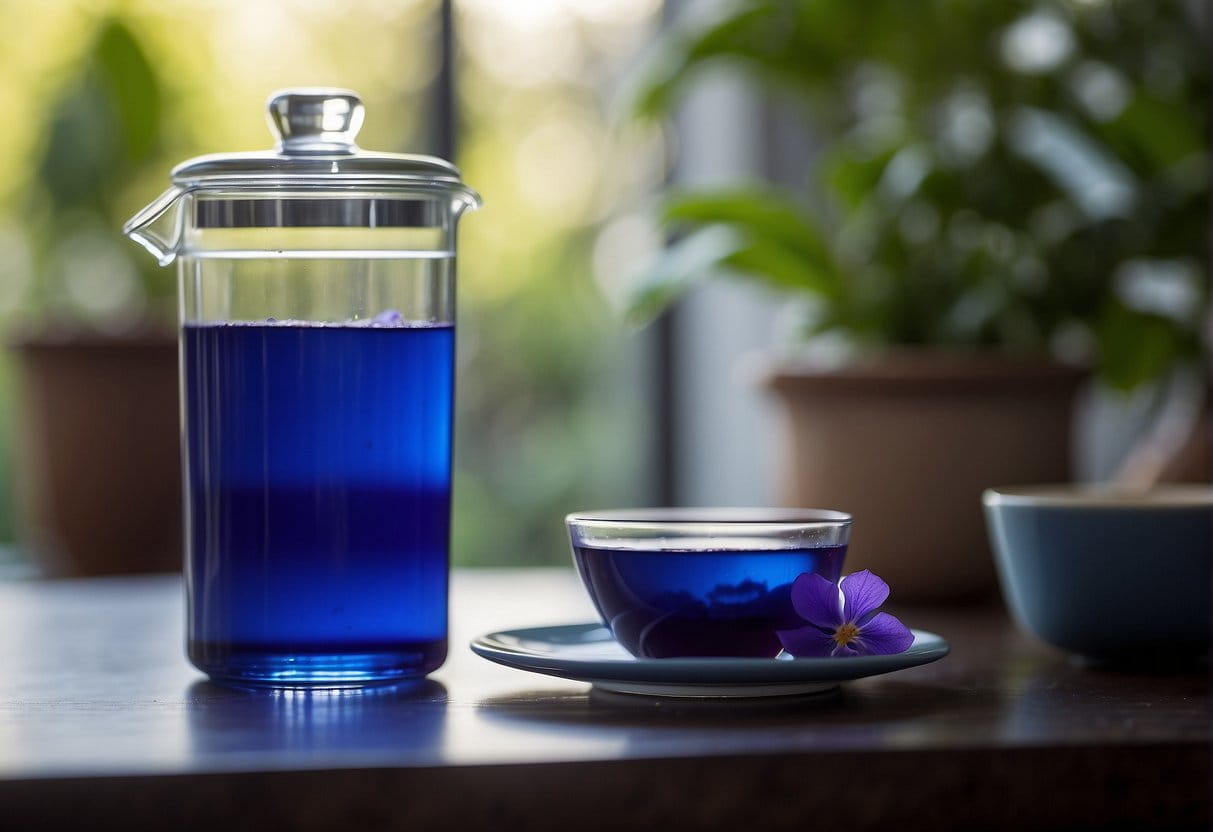
Butterfly pea tea is a unique beverage with a distinct profile that sets it apart from other teas. When you drink butterfly pea tea, you're indulging in an experience that isn't quite like any other tea. Its flavor is often described as earthy and woody with a subtle floral note.
Green Tea: You'll find green tea has a more grassy and fresh flavor compared to butterfly pea tea. Green tea is also known for its astringent properties, which butterfly pea tea lacks.
Black Tea: In contrast to black tea's robust and pronounced maltiness, butterfly pea tea is milder and doesn't exhibit the same level of astringency or bitterness.
Chamomile Tea: If you're familiar with the smoothly sweet and apple-like overtones of chamomile, you’ll notice butterfly pea tea exhibits a less overt sweetness, leaning more toward a neutral flavor palette.
| Aspect | Butterfly Pea Tea | Green Tea | Black Tea | Chamomile Tea |
|---|---|---|---|---|
| Flavor Profile | Earthy, woody, mildly floral | Grassy, fresh, astringent | Robust, malty | Sweet, apple-like |
| Astringency | Low | High | Medium to high | Low |
| Color | Bright blue, shifting to purple with pH changes | Pale green to yellow | Amber to dark brown | Golden yellow |
| Caffeine Content | None | Moderate | High | None |
Your cup of butterfly pea tea provides a caffeine-free option, which is not the case with black or green teas. It also has the unique characteristic of changing color to purple with the addition of citrus, creating a visually stunning experience that isn't found in other teas.
Health Benefits
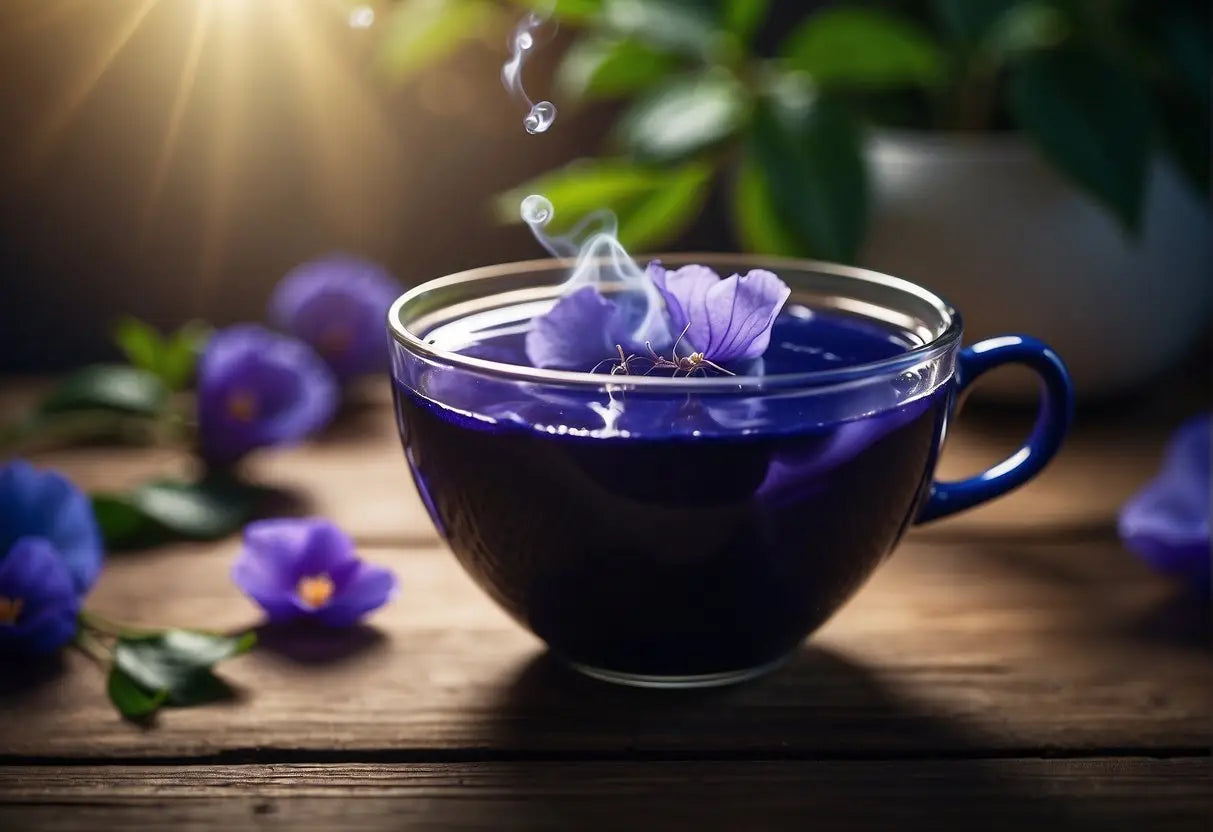
Butterfly pea tea is known for its potential health advantages due to its content of antioxidants. Antioxidants help combat oxidative stress, which is linked to numerous chronic conditions.
- Mind Health: This tea contains anthocyanins, which may improve brain health. Regular consumption could potentially enhance memory and stimulate brain activity.
- Anti-inflammatory Properties: The anti-inflammatory qualities of butterfly pea tea may alleviate certain types of swelling and pain within the body.
In terms of stress and mood:
- Stress Reduction: The tea's calming effects might help in reducing stress levels.
- Mood Enhancement: Some users report uplifted mood after enjoying this tea, although this is anecdotal and varies per individual.
Visual Health is another area of interest. Anthocyanins also benefit eye health by promoting increased blood flow to the optic nerves.
Blood Sugar and Weight Management:
- Blood Sugar: Preliminary research suggests possible benefits in managing blood sugar levels.
- Weight: Some find that butterfly pea tea supports weight loss efforts; it is a calorie-free drink that can be part of a weight management diet.
It is important to note that while these benefits show promise, they should not replace any medical treatments and you should consult with healthcare providers regarding their use in your health regimen. Claims are based on preliminary scientific research and individual experiences, and further studies are required to substantiate these potential health effects.
Cultural Significance
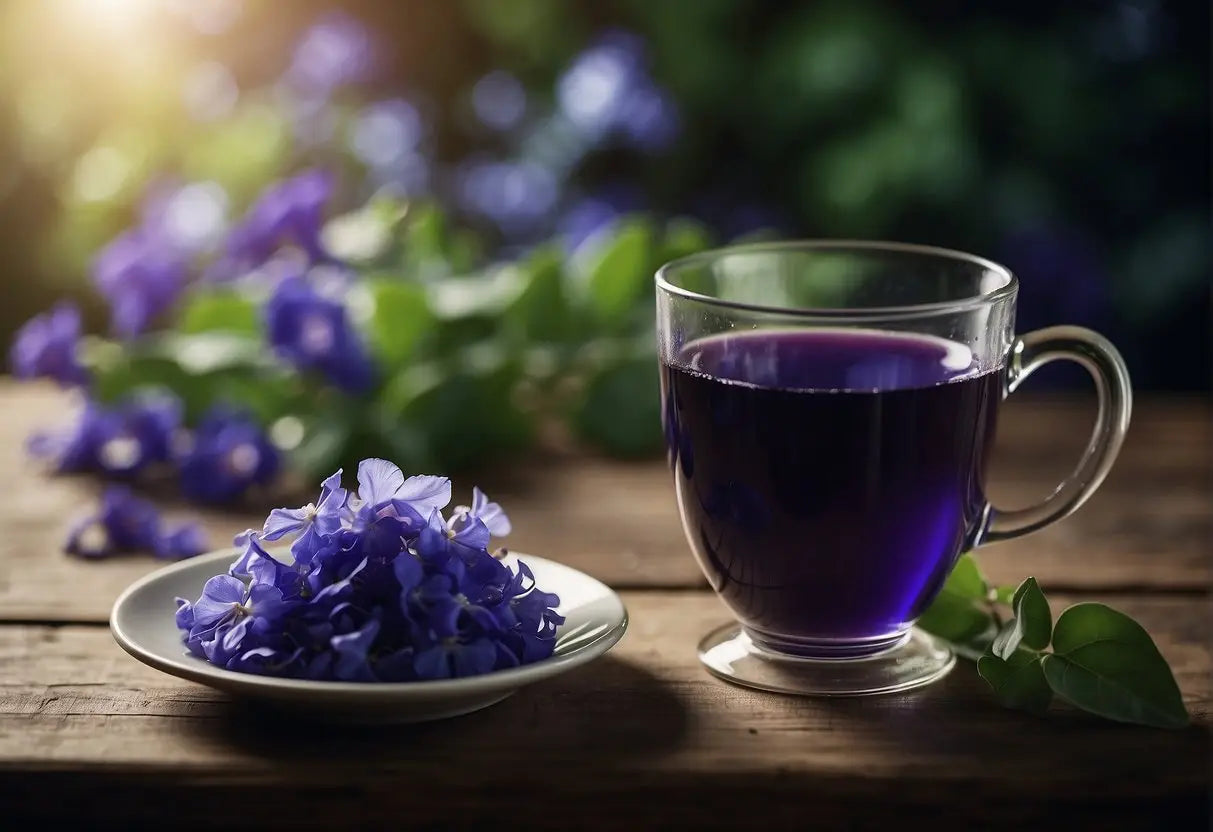
Butterfly pea tea, originating from Southeast Asia, is not only known for its vivid blue hue but also for its cultural importance. In regions like Thailand and Vietnam, you will find this beverage deeply rooted in local traditions and ceremonies.
Tradition: In Thai culture, butterfly pea tea is commonly served during special occasions and to welcome guests, symbolizing hospitality and respect.
Medicinal Uses: Many Asian cultures regard the tea as beneficial for health, traditionally used for its supposed anti-inflammatory and pain-relieving properties.
Festivals: During the Thai New Year, known as Songkran, the vibrant color of butterfly pea tea is integral to the festivities, reflecting the joy and energy of the celebrations.
Cuisine Integration:
- In Malaysia, this natural dye doesn’t just add color to tea — it's used in rice dishes like Nasi Kerabu, turning the rice a pleasing blue.
- Thailand and Vietnam incorporate the flower in desserts, often pairing it with lemongrass, coconut, and other local flavors.
Cultural Beliefs: Some communities believe in the butterfly pea flower's ability to affect mood positively, often associating it with happiness and peace.
Modern Adaptations: While deeply traditional, butterfly pea tea has been embraced by contemporary culture, incorporated into cocktails, and used as a natural food coloring in modern cuisine, allowing new generations to appreciate its cultural legacy.
You'll find that, beyond its taste, butterfly pea tea serves as a symbol of identity and tradition, linking you to the stories and practices of Southeast Asian culture.
Varieties and Blends
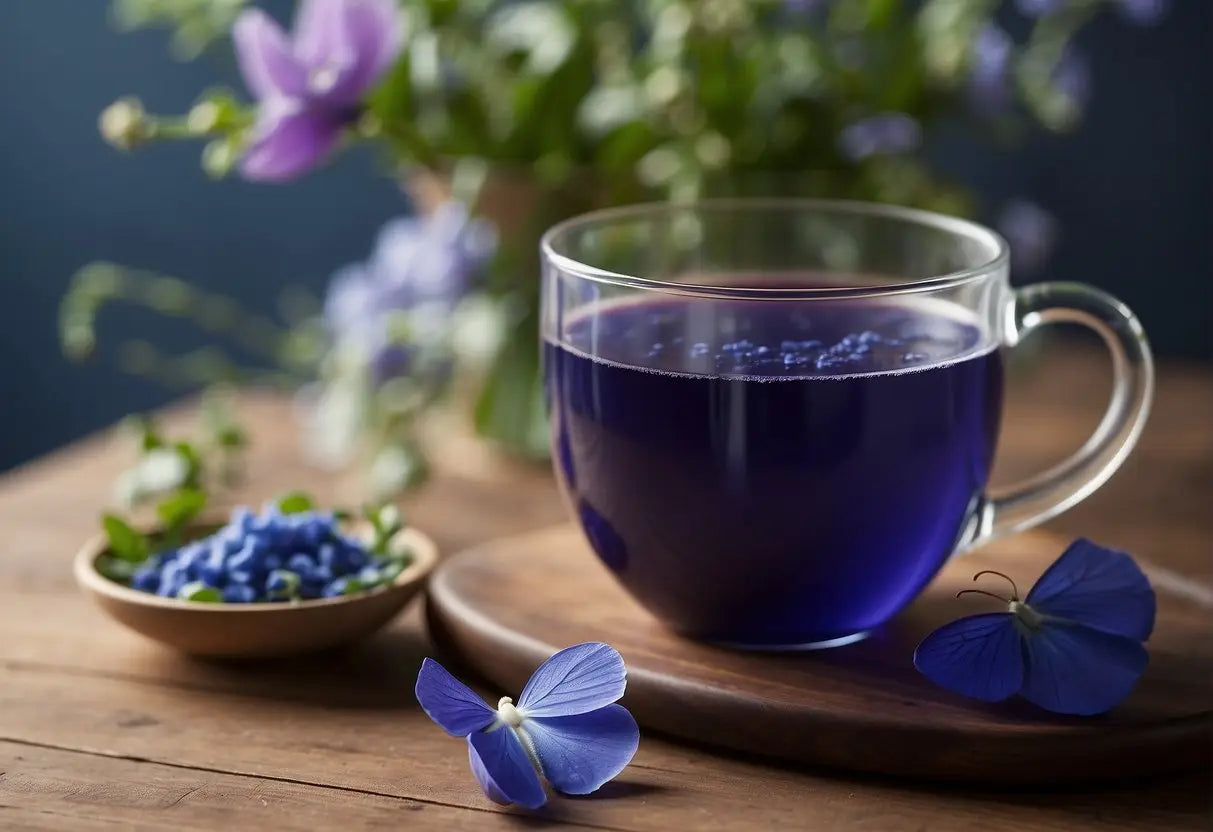
Butterfly pea tea, traditionally known as Clitoria ternatea, offers a range of varieties and blends. The basic variety is the pure butterfly pea flower tea, made solely from the petals of the butterfly pea flower. This version has a subtle, earthy taste, sometimes compared to a mild green tea or chamomile.
Enhanced varieties encompass:
- Lemongrass: Adds a citrusy note for a refreshing twist.
- Ginger: Provides a warm and spicy kick.
- Mint: Infuses a cool, crisp finish.
For a more aromatic experience, you might come across the butterfly pea tea blended with:
- Hibiscus: Introduces tartness and turns the beverage a vibrant pinkish-purple.
- Jasmine: Offers a fragrant, slightly sweet flavor.
Blended Teas:
| Ingredient | Flavor Profile | Color Alteration |
|---|---|---|
| Lemongrass | Citrusy, Refreshing | Slight |
| Ginger | Warm, Spicy | None |
| Mint | Cool, Crisp | None |
| Hibiscus | Tart, Vibrant | Pinkish-Purple |
| Jasmine | Fragrant, Slightly Sweet | None |
Custom Blends: If you're adventurous, consider creating your own blend. You can add:
- Honey or sweetener for sweetness.
- Lemon or lime juice, which will change the color to a purple or pink due to the pH change.
- Loose tea leaves like green or black tea for a caffeine boost.
Each blend affects the flavor profile, giving you a unique tasting experience. Experiment with different combinations to discover your preferred blend. Remember, the intensity of flavor comes down to the quantity of each addition and your personal taste preference.
Serving Recommendations

When preparing butterfly pea tea, the experience can be enhanced by how you serve it. Here are some serving recommendations to optimize your enjoyment of this unique beverage:
- Temperature: Serve hot or as an iced tea. For hot tea, steep at 100°C (212°F) for 4 to 5 minutes. For iced tea, chill after brewing and serve over ice cubes.
- Sweetness: If preferred, sweeten mildly with honey or sugar. Due to its subtle flavor, avoid strong sweeteners that may overpower the tea's natural taste.
Enhancements:
- Lemon Juice: Add a few drops of lemon juice to change the color from blue to purple and introduce a citrusy tang.
- Herbs and Spices: Mint leaves, lemongrass, or a cinnamon stick can add a refreshing twist or warm nuance.
- Floral Notes: Mix with other floral teas, like chamomile or jasmine, for a complex bouquet of flavors.
Pairings:
Pair your butterfly pea tea with:
- Light pastries or biscuits if enjoying as hot tea.
- Fresh fruits like berries or slices of citrus for iced variations.
Tip: Always use clear glassware to fully appreciate the tea's vibrant color transformation.
Frequently Asked Questions
Butterfly pea tea offers a unique taste and a range of health benefits. Below, you'll find answers to some common queries that can enhance your understanding and appreciation of this vibrant beverage.
How can I describe the flavor profile of butterfly pea tea?
Butterfly pea tea has a subtle earthy taste reminiscent of fine green teas. It's mildly floral with a slight woody note, providing a smooth and soothing drinking experience.
Does butterfly pea tea contain any caffeine?
This herbal tea is naturally caffeine-free, making it a suitable choice for individuals seeking a calming drink at any time of day without the stimulating effects of caffeine.
What are the health benefits associated with drinking butterfly pea tea?
Consumption of butterfly pea tea has been linked to a variety of health benefits, including improved cognitive function and stress reduction. It's rich in antioxidants, which can help in fighting inflammation and boosting overall well-being.
Can you explain the science behind the color change in butterfly pea tea?
The vibrant blue hue of butterfly pea tea results from compounds called anthocyanins. These are sensitive to pH, and when an acidic substance is added, like lemon juice, the tea changes color to purple due to a shift in the molecule's structure.
What are some recommended flavor pairings for butterfly pea flower tea?
Enhance your tea by pairing it with lemon, honey, or ginger. These ingredients not only complement the tea's natural taste but also contribute to color transformation and added health benefits.
In what ways does butterfly pea flower tea affect mood or feelings?
Drinking butterfly pea tea may have a calming effect, which can be attributed to its potential stress-relieving properties. It doesn't have sedative effects but may promote relaxation and well-being through its antioxidant content and sensory experience.
← Older post Newer post →











